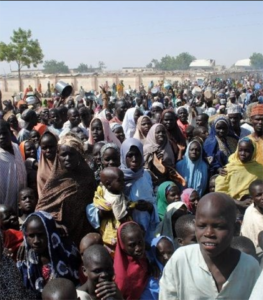Conflicts have displaced 41m people in their own countries – new data
A record 41.3 million people are now displaced within their own countries because of conflict or violence and two thirds of this group are located within just ten countries.
New data from the Geneva-based Internal Displacement Monitoring Centre (IDMC) shows that a million more people have become ‘internally displaced persons’ (IDPs) in the past year.
Unlike refugees or asylum seekers waiting for decisions on their refugee status, IDPs cannot claim international protection and often have less access to aid and medical care or other services.
“Unresolved internal displacement has all sorts of knock-on effects – one of them being that IDPs today could become refugees tomorrow,” IDMC Director Alexandre Bilak said in a statement this week.
Ms Bilak said the increase suggested that more global crises were long-lasting.
The data shows the number of people displaced within their own borders far exceeds those who cross into other countries – with 25.4 million refugees and 3.1 million asylum seekers worldwide in 2017, according to the United Nations refugee agency UNHCR.
Ongoing conflict in Syria and the Democratic Republic of Congo, and rising tensions in Ethiopia, Cameroon and Nigeria triggered most of the 10.8 million new displacements in 2018 linked to conflict and violence, the IDMC said.
Internal displacement is a hidden problem in many countries, such as Yemen, where the IDMC estimated 2.3 million people were forced to flee in 2018, although the number could be higher, Ms Bilak said.
“IDPs are certainly the most invisible. There are plenty of countries where we just don’t have an accurate picture of the scale of the phenomenon,” she said.
Also, disasters – largely extreme weather events such as cyclones and floods – forced 17.2 million from their homes in 2018, mainly in the Philippines, China and India, although such displacement was often short-term, the IDMC said.
Meanwhile, the UN World Meteorological Organization (WMO) says worldwide temperatures are on course to rise by 3 to 5 degrees Celsius by 2100, in excess of a global target to limit the increase to 2C.
That could increase the risk of extreme weather, as well as worsening hunger, poverty and water shortages, WMO says.
The IDMC says it is difficult to measure the numbers of people affected by natural disasters because of the difficulty in measuring people rapidly move on.
But it says cities are increasingly bearing the burden of hosting IDPs, both after natural disasters and as a result of urban warfare in places like Syria’s Daraa, Yemen’s Hodeidah and Libya’s Tripoli, the IDMC said.
Ms Bilak said cities needed to find ways to absorb these people.
“Even though the primary responsibility to address internal displacement lies with national governments, there’s a very important role that needs to be played by local governments and by municipalities,” she said.
Laurie Nowell
AMES Australia Senior Journalist












